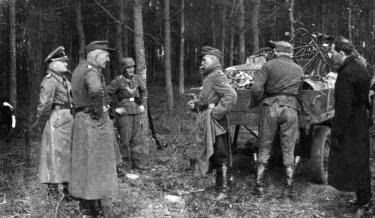At the start of September 1944, the various resistance groups joined forces under the name of the Nederlandse Binnenlandse Strijdkrachten (NBS: Netherlands Interior Forces). They began preparing for the liberation, and needed to be able to fight alongside the Allies and also to ensure order and peace after the liberation.
This is why, at the start of 1945, the resistance groups in Ede Municipality requested weapons from England, using the radio link provided by a secret agent. On 2 March, a successful drop took place at Keuenklep, a field surrounded by woods in the Wekeromse Zand area.
On 8 March, the resistance members gathered for a second drop. When a British Stirling bomber approached, the men on the ground used a white light to Morse the letter ‘G’ to the plane. This was the sign for the crew that they had reached the right location. Then a series of three lamps (red-white-red) on the ground indicated the wind direction. The plane turned, flew back and dropped the packages and containers. But unfortunately, the plane was flying transverse to the wind and the parachutes drifted off to the southern edge of the wood. Working in the dark, the men on the ground gathered the majority of the supplies.
That evening, the Germans had seen a suspiciously large number of cyclists heading in one direction, and had sent out extra patrols. On their way home, some small groups of resistance members ran into these German patrols. Fourteen men were taken prisoner, and another six in the following days. In the morning of 9 March, the Germans discovered the Keuenklep field with the remaining parachutes and containers in the trees.
The Germans took the captured resistance men to Hotel De Wormshoef in Lunteren, the headquarters of the Sicherheitsdienst (SD: the SS intelligence agency). Some prisoners were also taken to the adjacent Villa Eekhorst. The resistance members were interrogated roughly and tortured by the SD. Two men were able to escape, and one was released. Seventeen men were transferred to death cells at Amersfoort Camp, where one of them died. The other sixteen men were shot on 20 March 1945. Most of them are interred in the Mausoleum in Ede.
Do you want to experience this story in its original location? Then visit the information panel at Hoge Valkse dijk, indicated by a blue track and a black star.

